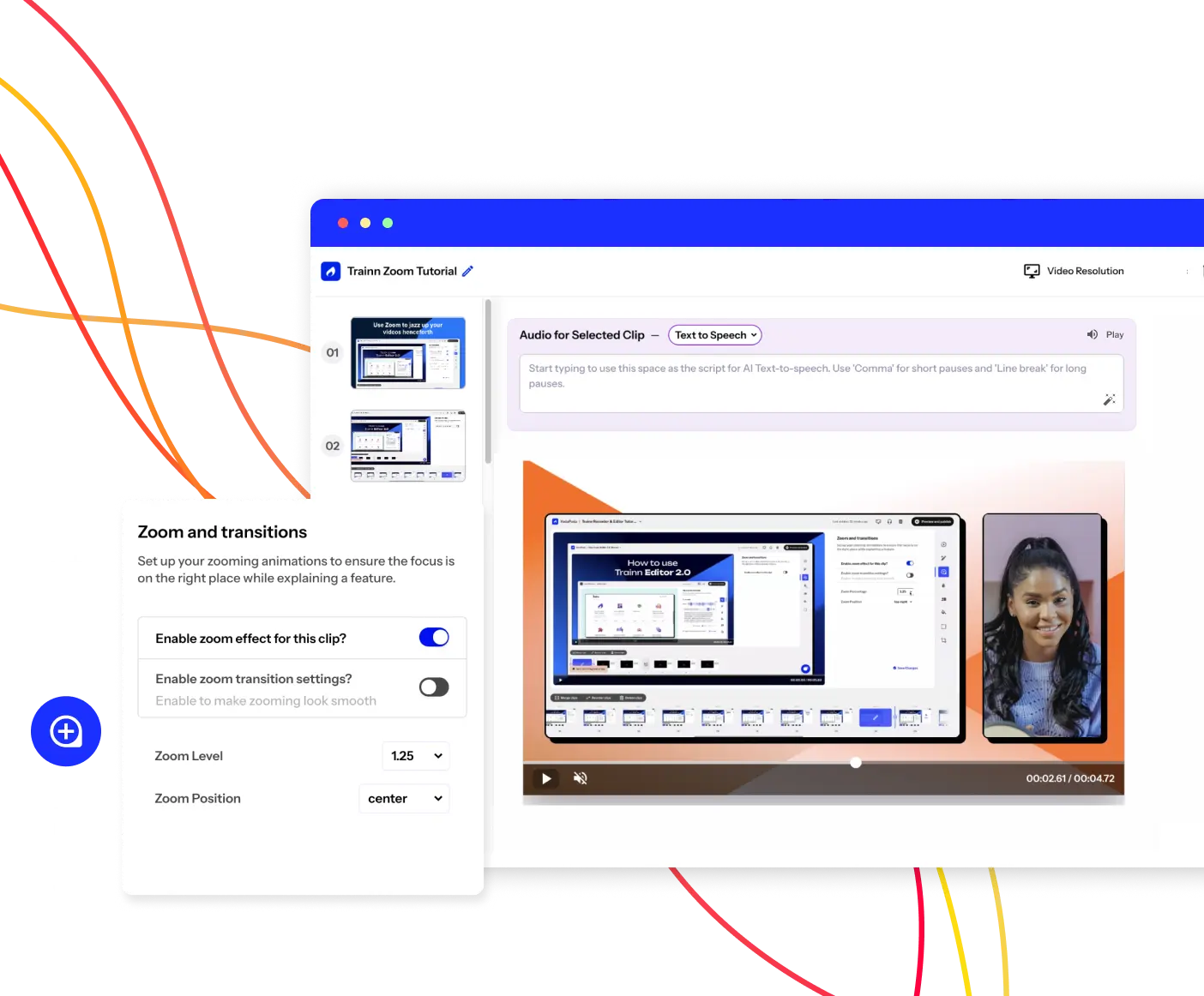- Features
- Resources
- Pricing
Create Stunning Product Videos with AI
Meet Trainn: An AI-powered video creation tool to create videos of your digital product in 5 minutes and at scale.
Free for 14-days. No credit card required.
Related terms
Video Subtitles
What are Video Subtitles?
Adding subtitles to videos opens your content to wider audiences and improves comprehension. Video subtitles display text on screen that transcribes dialogue, narration, and other audio in a video. Subtitles allow viewers to read what is being said if they are unable to hear it clearly.
Benefits of Video Subtitles
Accessibility
Deaf and Hard-of-Hearing Viewers-Subtitles make content accessible to individuals who are deaf or hard of hearing. They can follow the dialogue even without audio.
Audio-Processing Disorders-Subtitles benefit those with auditory processing disorders, ensuring they don’t miss crucial information.
Language Support
Global Reach- Subtitling videos in multiple languages allows you to connect with diverse audiences worldwide. Language barriers are overcome, expanding your viewership.
Viewing Context
Noisy Environments- In loud surroundings, viewers can still understand the content by reading subtitles.
Silent Viewing- Subtitles are essential when viewers need to watch videos silently, such as in libraries or public transport.
SEO Value
Search Engine Optimization- Search engines crawl text content, including subtitles. Adding relevant keywords enhances video discoverability.
Comprehension
Dual Sensory Input- Reading reinforces information retention. Viewers both see and hear the content, improving comprehension.
Video Distributability
Platform Requirements- Many platforms, including social media, YouTube, and broadcast TV, mandate subtitles. Compliance ensures wider distribution.
How Do Video Subtitles Work?
The subtitling process involves:
- Generating a video transcript via automated transcription or manual notes.
- Timing subtitles to match the dialogue flow and breaks.
- Formatting text aesthetically - font, size, color.
- Placing captions optimally so they do not obscure visuals.
- Translating subtitles into other languages.
- Adding the finished files to the video.
- Encoding subtitles directly into the video stream.
Types of Video Subtitles
Common subtitle types include:
- Closed captions - Subtitles embedded in the video for devices to decode.
- Open subtitles - Permanently overlayed text burnt into the video file.
- Sidecar files- Subtitle files played synchronized alongside the video.
- Burned-in- Subtitles permanently embedded into each video frame.
- Closed captioning specifically provides aid for those with hearing impairments.
Challenges of Video Subtitling
Potential hurdles include:
- Difficulty Understanding Mumbled or Accented Speech - Accurate transcription becomes challenging when speakers mumble or have strong accents. Contextual understanding is crucial.
- Time-Intensive Manual Transcription and Timing - Creating precise subtitles involves transcribing spoken words and synchronizing them with video timing. It’s a meticulous process.
- Visual Clash with Videos - Subtitles must be visually pleasing and not distract from the video content. Font choice, size, and positioning matter.
- Translating Subtitles into Localized Languages - For global audiences, translating subtitles accurately while maintaining context and cultural nuances can be complex.
- Preventing Subtitles from Lagging and Getting Out of Sync - Technical glitches can cause subtitles to lag or fall out of sync with audio. Regular checks are necessary.
- Platform Specifications Vary for Subtitle Formats - Different platforms accept various subtitle file formats (e.g., .srt, .vtt). Adapting to each platform’s requirements is essential.
- Displaying Subtitles Properly Across Devices and Players - Subtitles should appear correctly on various devices (phones, tablets, computers) and media players. Testing ensures compatibility.
Choosing Subtitle Software
Automated tools like Trainn overcome these challenges by:
- Automating transcription with accurate speech-to-text
- Streamlining timing with configurable timestamps
- Enabling custom styling - fonts, colors, etc.
- Translating subtitles into any language
- Sync checking to fix drifting captions
- Multi-format exporting - SRT, SCC, WebVTT, etc.
- Platform publishing directly to popular destinations
- Caption burn-in to embed text in video frames
FAQs
What is the optimal subtitle length?
Ideally between 35-44 characters per line for readability.
How are closed captions different from subtitles?
Closed captions specifically provide aid for the deaf or hard of hearing.
What's the importance of proper subtitle placement?
Strategically place subtitles to avoid obstructing essential visuals and maintain a seamless viewing experience.






